
Page 1
Quilting with the NEW Grace A34
TM
Quilting Frame
Table of Contents
Care of your Grace Frame ............................. 2
Correspondence and Technical Support........ 2
Warranty information ...................................... 2
Parts Lists ....................................................... 3 - 4
Assembly
Leg and End Assembly ....................... 5
Brace Assembly ................................... 6-7
Pole Assembly ...................................... 8
Cog Wheel Assembly .......................... 9
Cog Stop Assembly.............................. 10
Assembly of Accessories
Super king extension assembly
Brace ......................................... 6
Pole ............................................ 8
4
th
Pole Kit Attachment ......................... 10
Edge Master
TM
Application ................... 17
Folding the Grace Frame ............................... 11
Making and using cloth leaders ..................... 16
Quilting instructions ........................................ 12-14
Trouble shooting ............................................. 14-15
Copyright December 1997 Jim M. Bagley
GraceWood, Inc. Reproduction Prohibited,
Patent Pending

Page 2
Care of Your Grace Frame
The frame may be sealed and/or stained with an application of tung oil which will help preserve the
wood and will help to prevent warping. To add a certain color to your frame, you may use a Danish
Oil finish. We recommend the Deft
TM
or Watco
TM
brands.
Many different finishes and/or stains may be suitable for sealing and beautifying your Grace Frame
TM
. You may want to consult your local paint retailer for finishes which will apply easily and dry hard,
not oily.
Tips
-Store frame in a dry place--preferably with poles and braces in vertical position if not assembled.
-Do not carry the frame by the quilting poles.
-Do not drop the frame or let it twist out of square.
Grace Frame Lifetime Limited Warranty
We will replace any part that fails to work for any reason other than loss or intentional
damage by the purchaser. This simply means that “if it breaks, then we will fix it.” We will even pay
the freight if it is our fault and if the problem is made known to us within one year after the purchase
date. After one year we will replace any part for as long as we are in business (forever we hope). We
will repair or replace any defective part free of charge during the one year warranty period. After
the warranty period has expired we will replace any part for the cost of shipping and handling of that
part. Any broken or damaged part must be sent postage paid to the Grace Company before
replacement can be made.
For correspondence concerning your Grace
Frame
TM
, write to:
The Grace Company
P.O. Box 27823
Salt Lake City, UT 84127
For Shipping of materials to the Grace Company
address package (postage prepaid) to:
The Grace Company
801 West Layton Avenue
Salt Lake City, UT 84104
For technical support, call (801) 972-5801 All calls will be returned
E-Mail Address: [email protected]
Web Site: http://www.graceframe.com
About the Grace Quilting Frame
The Grace Quilting System has been developed over the past decade with several original design
innovations. Due to feed back from many of the thousands of quilters who have purchased and do
use the Grace Frame
TM
we have been able to make a frame that will really enhance the entire
process of hand quilting from beginning to end. If you have any suggestions that will help us to
improve our product or service, please write to the Grace Company.
Thank you and Happy Quilting!

Page 3
ASSEMBLY OF The A34
TM
QUILTING FRAME
UNPACKING
Using the parts list as a reference, take all of the parts out of the box and make sure that you
have all the parts. (If there is something missing or broken, contact The Grace Company. We will promptly
ship any needed item).
TOOLS
To assemble the Grace Frame you will need a few common tools. Once the frame is
assembled tools will only be needed to fold or disassemble the frame. Make sure that these
tools are clean and free of grease.
1. One ratchet driver with one 1/2" socket and
one 7/16" socket. Combination / box wrench may be
used.
2. One Phillips #2 screwdriver (if installing the
4
th
pole kit).
SECTION 1. Leg to End Assembly
Parts needed: 1 each # RE28A34 Right End
1 each # LE28A34 Left End
1 each # RRLA34, # RFLA34,
# LFLA34, # LRLA34 Legs.
8 each 5/16" X 1-1/2" hex head bolts
8 each 1/4" flat washers (smaller washer)
RIGHT END
Step 1.
Start with part RE28A34 Right End
Make sure you know which side is the top and
which side is the front. (See picture) Position
part on floor with metal inserts facing the floor.
The front of the part should be to your right and
the top edge should be facing away from you.
Step 2.
Take the leg parts # RRLA34 and # RFLA34 Legs and
position them so the holes match up over the holes in End
Board as shown in drawing.
Insert 5/16" bolts through 1/4" washers.
Step 3.
By hand, start each bolt through each Leg hole and
continuing through End board hole into the T-nut. Make
sure all four bolts have been started into the threads of
the T-nut before tightening with the 1/2"
wrench.
LEFT END
Repeat these steps for the right end with part # LE28A34
Left End and leg parts # LFLA34 and # LRLA34
Part # LE28A34 Left End should be placed on the floor with the metal tee nuts facing the floor
and the front to your Right*
*TIP— Legs holes will not match if you try to put them in the wrong place.

Page 4
SECTION 2. Brace Assembly
Parts needed: 2 each part # BRUP59A34 Upper Braces
2 each part # BRLO61A34 Lower Braces
4 each 5/16" x 1-1/2" Hex Head Bolt
4 each 5/16" (Larger) Flat Washer
If Super King* or Extra Long Super King** Extension Is Used
1 each part # UP2125SKA or # UP4075XLSKA Upper Double End Brace Extension
1 each part # LO23SKA or # LO425XLSKA Lower Double End Brace Extension
8 each 5/16" x 1-1/2" Hex Head Bolt
8 each 5/16" (larger) Flat Washer
Decide which size quilt frame you will need to put up. (See sizes in drawing)
Brace Assembly Chart
Tee Nuts should always be visible and facing out. ** Optional Extensions are available at extra cost.

Page 5
Step 1.
Select the two part # BRUP59A34 Upper
Braces and place them side by side with
Tee Nuts in each part FACING OUT. The
keyed ends should be pointing in opposite
directions.
Step 2.
Slide the two parts against each other in a telescoping fashion until the T-nut hole lines up with
the
desired slot for the size frame that you need to set up.
*TIP--The overall length of the brace will be about 4-1/2" inches larger than the quilting space.
Step 3.
Put the large washer on the 5/16" x 1-1/2" bolt and start through the slot first, and continuing
through the round hole and into the metal T-nut.*
*TIP--Do not tighten bolts at this time (the braces will be adjusted later in the assembly process as
instructed)
Step 4.
Repeat these above steps with the other two brace parts # BRLO61A34 Lower Braces.
SECTION 3. Brace to Leg/End Assembly
Parts needed: 4 - 1/4" (smaller) Washer
4 - Rectangle Cross Nuts
4 - 1/4" x 2" Hex Head Bolts
Left and Right End assembled with
Legs
Both assembled Braces
7/16" Wrench
Step 1.
Place the keyed end of the brace into the
holes in the 3/4" x 2-1/2" slots which are
located on the inside of the Rear Legs. See
Drawing On Page 7.

Page 6
Step 2.
Place a 1/4" (smaller) Flat Washer over the end of the 1/4" x 2" Bolt. Thread the 1/4" x 2" Bolt
into the hole outside of the slot and into the brace. Place the cross nut in the slot so the
threaded hole lines up with the bolt. Tighten the bolt into the cross nut until the brace is pulled
all the way into the slot. This should be a good, solid joint. Repeat this step using the Upper
brace assembly and install it into the
slots in the end boards.
*Tip--Very Important —The Braces are keyed
on the ends so that you cannot insert them into
the wrong slot. If the braces are put together
properly with the tee nuts and the cross nut
slots facing out, then it is virtually impossible to
put them in wrong.
SECTION 4. Quilting Pole Assembly
Parts needed: 3 or *4 PL48-5 D
3 or *4 PL19-5 E
3 or *4 PL55-5 F
3 or *4 PL22-0 G
4- per pole 1/4" X 1-1/2" hex
bolts
4- per pole 1/4" flat washers
(small)
* If optional fourth pole is being used.
Step 1.
Before beginning assembly of quilting poles, determine which size of the frame you are putting
up, using the diagram on page 9. Select the correct parts in order to assemble three or 4*
pole units.
Step 2.
Align the slanted ends of the pole parts
together and insert each 1/4" x 1-1/4"
bolt through a small flat washer and
into the round hole in the wood and
continuing into the metal T-nut. Begin
all the bolts, then tightly holding the
wood pole together align it squarely on
all sides. Now use the socket to
completely tighten all bolts. Continue
bolting together all slanted ends of
poles until you have three quilting poles
completed.

Page 7
Pole Assembly Chart (By Length Of Quilting Space)
Quilt must be at least 1" smaller than the overall length of pole
** Optional - Available at Extra Cost
SECTION 5. Quilting Pole to end Assembly
*Tip— Keep these cogwheel positions (as illustrated
below) in mind while assembling the Quilting Poles
to the Ends.
Parts Needed: 3 - Assembled Quilting Poles
6 - 2" Plastic washers
1/2" wrench
7/16" wrench
3 - # CW625 Cog Wheels
3 - # CS152 Cog Stops
3 - 1/4"x 1 - 1/2" hex head bolts
Step 1.
Slip the cog wheel onto the quilting pole. Slip one of the plastic washers onto both ends of the
pole. Stand facing the front of the frame.
Step 2.
Position the Quilting Pole end (the
end that does not have the cog
wheel on it) into the left front hole
in the left end board.
Step 3.
Depress the spring loaded pole
end on the opposite end of the
pole and slip that end into the
pole on the right end.
*Tip— You can adjust the frame longer
or shorter if you have not tightened the
bolts in the braces.

Page 8
Step 4.
Adjust the brace slots until the frame poles will roll freely, but will have no space between the
end of the poles and the end boards. Tighten the brace bolts with 1/2" socket wrench.
Step 5.
Install the cog stops or pawls with 1/4" x 1-1/2" bolts.
*Tip— Tighten bolt with fingers only into the 1/4" wood insert in the Right End until they are snug. DO
NOT OVER TIGHTEN BOLT.
SECTION 6. 4
th
Pole Kit Assembly (optional)
Parts needed: 1- # D PL48-5
1- # E PL19-5
1- # F PL55-5
1- # G PL22-0 (or 2 with optional Super King Extension)
2 - # A34-4PB Rear 4
th
Pole Mounting Brackets
2 - 2" Plastic Washers
4 - 1/4" x 1-1/4" hex head bolts ( or 6 with Super King
Extension)
4 - smaller 1/4" x 1-1/4" washer (or 6 with Super King
Extension)
4 wood screws 1-1/8" long
Phillips screwdriver #2
Step 1.
The 4
th
Pole is attached to rear legs of the frame with two easily
installed brackets #A34-4PB. Locate the brackets over the pre-
drilled holes on the rear legs with the large hole on the bracket
completely accessible behind back edge of the leg.
Step 2.
Begin the screws through the bracket and into the leg wood.
Completely tighten the screws.
Step 3.
Assemble the 4
th
pole to desired length as described
in Section 4 “Quilting Pole Assembly” excluding the
Cog Wheel (the 4
th
pole must roll freely at all times).

Page 9
SECTION 7. Using the Fold Up Feature
The fold-up feature of the frame is really impressive.
It takes only about two minutes to fold up the frame
into a package which will take only about 9" of floor
space. The quilt can be left on the frame and it will
remain intact while the frame is folded. You may
need two people to accomplish this procedure
easily with the longer frames.
Step 1.
Remove the Lower bolt from both legs. Loosen the
Upper bolt on both front legs.
Step 2.
Fold the front legs forward 90
o
.
Insert the bolt that you removed
into the new hole and thread it
into the tee nut without
tightening both bolts at this time.
This should be done on both
front legs.
Step 3.
Remove Top bolts on both
rear legs. Loosen Lower bolts
on both rear legs.
Step 4.
Rotate rear legs Forward 90
o
.
Insert the bolt that you removed into the hole about halfway down the leg (this will match the
hole left vacant by the front leg. This should be done on both rear legs. Tighten all bolts. (See
diagram)
*Tip— Do not loosen the bolts which are holding the braces to the right and left leg/end assemblies.
THIS IS VERY IMPORTANT. If the bolts are loosened, the frame will not be stable for folding or for
unfolding.

Page 10
HOW TO USE YOUR GRACE A34
TM
QUILTING FRAME
GET READY: Your quilt fabric may be tacked directly to the poles. However, using cloth leaders is a
much better way to attach your quilt (see the cloth leader instruction sheet). Leaders are easy to
make and allow the quilter to move the last few inches of the quilt forward from the rear pole to the
front quilting area. If you choose to use leaders refer now to the instructions for making leaders and
make them before proceeding to put a quilt on your frame.
*Tip--If you will be using the 4
th
pole kit (optional) for rolling the batting onto, make sure the 4
th
pole
kit is assembled and in place before using your frame.
GET SET: You will put the BACKING for the quilt on the frame first. We recommend the backing always
be 2" to 4" longer than the top from front to back, especially if your top is pieced rather than whole
cloth. A pieced top may stretch out and be larger than the backing if you do not make this
allowance.
If you use unseamed cloth for the backing, you may skip the following discussion.
Pieced Backs: Cut off the selvedges before you piece the back. The selvedge is woven tightly and
won’t have the same “give” in the seam. If you have problems with lengthwise seaming being too
tight, try the optional crosswise piecing of the back or simply put the quilt on the frame crosswise.
GO: You will need large head, short shank tacks, tack hammer, tack lifter. If you are using Leader
Cloth, then it should be installed at this time and you will need tacks only to install the Leaders.
Step 1. Backing Installation
BACKING: Fold the backing fabric in half and mark both
top and bottom with a pin or pencil mark. Tack
the center mark (inside of backing face up) to the
center of the front pole. Do not stretch the fabric.
Tack the corners of the fabric to pole. Measure
again to see if backing is centered at an equal
distance from the outside edges of pole. We will
finish tacking the front down after the back is
attached to the middle pole. You need only a
few tacks in it to hold it in place, and if you need
to make adjustments you will have to remove only
those few tacks. Tack the other end of the
backing fabric to the middle quilting pole,
centering with the mark as on the front pole.
Tack the center and tack the corners, compare
with front pole--the amount of pole wood showing
beyond the edges of quilt should be equal on
both sides. After you have it positioned, tack
securely along the entire edge of the middle pole, using plenty of tacks.
Step 2. Backing Roll Up
Roll the material onto the middle pole, making a smooth roll. Be sure that no large wrinkles are
present. Smooth the quilt from the center to the outside edges of the pole as you roll. At this
point you do not have to roll the fabric tightly, just nice and even and smooth. Roll until the

Page 11
fabric is without much slack between the two poles.
Now, from the front of the frame, look at the fabric and
re-adjust the fabric on the front pole if necessary.
Sometimes, due to the grain line of the fabric, the
fabric will be loose in one area and tighter in
another. Even the tension by adjusting the tacks
on the front pole. .
Step 3.
BATTING: There are four ways to use the batting so decide now which way you will use.
#1 Batting is rolled up with the quilt top onto the rear pole.
#2 Batting is left hanging free off the middle pole.
#3 Delicate or unbonded batting rolled similar to method #1 if 4
th
pole is not used.
#4 The optional 4
th
pole kit is used to roll batting (highly recommended for delicate batting).
#1 Batting With Top: Place the batting on top of the backing fabric evenly along the front pole and
tack to front pole, centering the batting. If you use this method, the quilt top will be needed at
this point, as it is rolled with the batting onto the rear pole. Take the quilt top and center it over
the center mark of the quilt backing on the front
pole. Tack it down, starting in the center and
moving outward to the edges. All three layers will
now be tacked to the front pole. Tack the other end
of the batting and top material to the rear pole.
Measure to ensure that all the fabric is centered.
Smoothly roll these layers onto the rear pole. Roll
until the materials are smoothly and tautly stretched
between the poles. Adjust the bottom tension by
rolling the middle pole until you get the material to
the desired tension. DO NOT OVER-TIGHTEN. Apply
the wood stop to the cog wheel. Adjust the tension
of the top and the batting by rolling the rear pole
until you get the layers to the desired tension. DO
NOT OVER-TIGHTEN. Apply the wood stop to the cog
wheel.
#2 Batting Hanging: Bonded batting is recommended for this method. Center the batting on the
front pole on top of the quilt backing. Tack down with a few tacks. Smooth the batting over
the backing and let it hang free behind the middle pole to the floor. This is a slick, fast method
and seems to ensure a smoother roll for me personally than method #1 and is much easier
and faster to roll the quilt top onto the frame without the batting being in my way. As you quilt
and roll the batting, smooth the batting from underneath at the middle pole with each roll....it
works great.
#3 Delicate Batting Method: Lay the quilt top fabric out wrong side facing up and place the delicate
batting on top. Tack these two layers together to the rear pole--see sketch— and roll the
fabrics onto the rear pole. Next, smooth out the two layers and tack them to the front pole,

Page 12
centering the quilt top to the center of the quilt
backing. (See Drawing Above.)
#3 Batting using the 4
th
pole kit: Make sure the 4
th
pole is properly installed on the frame before
proceeding. Center the batting out over the
backing and over the middle pole and hang
down from the middle pole and wrap around
the 4
th
pole. You don’t need to tack the
batting to the fourth pole, just roll it up
carefully. Refer to the 4
th
pole kit instructions.
Step 4. Top Installation
QUILT TOP: If you used method #1, batting roll, you
would have rolled the top on with the batting
and would now be ready to quilt. If you used
methods 2 or 3, you will now need to attach
the quilt top. Fold the quilt top in half and
mark the center of the top and bottom edges
with pins or pencil mark. Tack the center of the
quilt top onto the center of the center mark of
the rear pole. Tack corners and smooth out
fabric from the center point of pole to outside
edges of the pole as you roll. Use the pattern
of the fabric, such as a row of blocks, to guide
your rolling. Roll until the fabric is almost all on
the rear pole. Bring enough of the quilt top to
the front pole to tack down. Tack the center
mark of the quilt top over the center mark of the quilt backing and tack down along the length
of the pole, smoothing from the center out. Do not stretch the fabric as you smooth it out to
tack. You may choose to pin the quilt top to the backing at the front rail. Adjust bottom
tension by rolling the middle pole until you get the material to the desired tension. DO NOT
OVER-TIGHTEN. Apply the wood stop to the cog wheel.
HAPPY QUILTING!
TROUBLE SHOOTING
Problem: Fabric sags on one side or in middle.
Solution
: Fabric may not be cut evenly straight or the grain of the cloth may not be square. Take it off
and square it up or pull (gently) to square.
Problem: Batting tears or separates during the tightening of the ratchet wheels.
Solution:
The Batting was stretched and stressed. The Batting should be longer than the Quilt that you
are making and there should be no tension applied to it. Remember to use a few extra inches of
Batting and let it sag down between the two rear poles. This will stop the Batting from pulling. You may
unroll the rear pole and fix the Batting at any time during the quilting process.

Page 13
Problem: Sides of quilt have a concave edge.
Solution: The fabric was stretched along the pole. Take the fabric off and let it relax until it is not
misshapen and then re-install, without stretching it along this edge.
Problem: Poles are bowing in.
Solution: The causes may be: 1. Seam down the center of the Fabrics may be sewn too tightly and is
not giving with the rest of the Fabric. If the Seam is the problem the Quilt may be attached sideways,
2. Fabric is not cut evenly. 3. Too much tension has been applied. 4. Fabric has been stretched
along the Poles instead of naturally laid along the Poles then attached.
Problem: Fabric pulls/tears out at the Thumbtacks when tension
is applied.
Solution: Seat the Tack all the way in. The Head of the Tack,
not the post of the Tack, should hold the Fabric. Use a Tack
Hammer to seat the Tacks if your hand is not strong enough.
Problem: Poles squeak as they roll or they do not roll freely.
Solution: Make sure that the frame is in good square
alignment. You may have to loosen the braces and square the frame both horizontally and vertically.
You may also rub some Paraffin or Candle Wax on the Dowels in the ends of the Poles.
Helps for Tied Quilts:
Before installing the Quilt onto the Frame, mark both the Quilt Top and Backing in a similar increments
along the two side edges. (The sides that are not tacked onto the Poles.) While rolling the Quilt during
the tying process watch the marks. This will help you to keep an equal tension on the Top and Backing
Fabrics so you won’t over tighten one or the other of your Fabrics. When rolling into a new area of tying,
allow your last row of ties to
remain in the new area of tying.
Also, tie your knots tight. Do Not
over roll your last row of ties
over the turn in the Pole.

Page 14
Making and Using
Cloth Leaders
Use of cloth leaders
< This is only a suggestion for making one kind of cloth leaders. There are many ways and ideas
for making cloth leaders. Don’t hesitate about trying your own ideas. Just remember that the
widest strip of fabric should be applied to the rear pole. This allows the whole quilt to come up
into the area of quilting without stopping and adjusting the quilt top to the second pole in order
to finish it.
< The best cloth selection for making cloth leaders is unbleached muslin or mattress ticking.
However, the ticking is a much more expensive selection.
< Purchase:
< 1-2/3 Yards of Fabric to make 59" Crib Size Leader
< 2 Yards of Fabric to make 73" Twin Size Leader

Page 15
< 2-2/3 Yards of Fabric to make 95" Queen Size Leader
< 3 Yards of Fabric to make 109" King Size Leader
<
< Step 1. Cut the fabric as shown in illustration above.
< Step 2. Finish the cut edges of the leaders with either a serge stitch or with a very straight 1/2"
hem allowance. Press the leader cloth with a warm iron.
< Step 3. Draw straight, dark, solid line 1" from one edge of each of the leader cloths.
< Step 4. Thumb tack the cloth leaders to the poles as shown on illustration below.
< Step 5. Pin or baste your quilt fabrics to the cloth leaders. Use the dark, straight line that you
marked on your leaders in Step 2 to align your quilt fabrics with.
< Step 6. Roll the Cloth Leaders and Quilt Fabrics up on Poles.
< Step 7. You are now ready to begin quilting.

Page 16
Using The Edgemaster
TM
The Edgemaster
TM
is an optional device that keeps the side tension of the quilting fabric even. This
clamp is reversible and is sold in sets of two. There is no right and left side, one Edgemaster
TM
will work
on either side of the frame. Step 1: Loosen wooden nuts to their maximum open position.
Step 2: Separate the two boards of the Edgemaster
TM
and position them with the quilting frame poles
or hoop sides between the two Edgemaster
TM
boards.
Step 3: Pin quilt edge to muslin strip.
Step 4: Tighten the wooden nut down as you pull gently on the Edgemaster
TM
to achieve desired side
tension. Do not distort fabric by pulling it too tautly.
-
 1
1
-
 2
2
-
 3
3
-
 4
4
-
 5
5
-
 6
6
-
 7
7
-
 8
8
-
 9
9
-
 10
10
-
 11
11
-
 12
12
-
 13
13
-
 14
14
-
 15
15
-
 16
16
Grace Company The A34 User manual
- Type
- User manual
- This manual is also suitable for
Ask a question and I''ll find the answer in the document
Finding information in a document is now easier with AI
Related papers
-
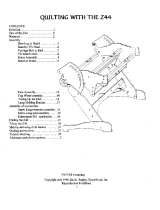 Grace Company The Z44 Operating instructions
Grace Company The Z44 Operating instructions
-
Grace Company Z44 New Millennium User manual
-
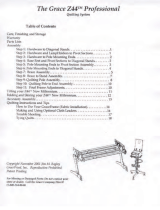 Grace Company The Z44 Operating instructions
Grace Company The Z44 Operating instructions
-
 Grace Company The Z44 Operating instructions
Grace Company The Z44 Operating instructions
-
 Grace Company The EZ3 Operating instructions
Grace Company The EZ3 Operating instructions
-
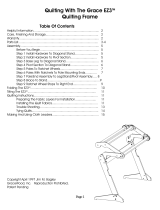 Grace Company The EZ3 Operating instructions
Grace Company The EZ3 Operating instructions
-
Grace Company The A34 User manual
-
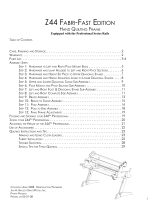 Grace Company The Z44 Operating instructions
Grace Company The Z44 Operating instructions
-
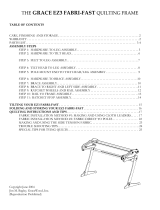 Grace Company The EZ3 Operating instructions
Grace Company The EZ3 Operating instructions
-
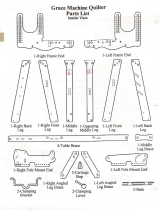 Grace Company Original Grace Machine Quilter Operating instructions
Grace Company Original Grace Machine Quilter Operating instructions
Other documents
-
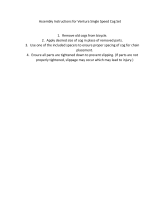 Ventura 320070 Operating instructions
Ventura 320070 Operating instructions
-
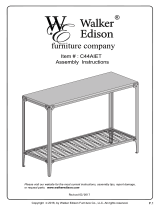 Walker Edison Furniture Company C44AIETBW Operating instructions
Walker Edison Furniture Company C44AIETBW Operating instructions
-
POLYWOOD TD102GY Operating instructions
-
POLYWOOD TD101WH Operating instructions
-
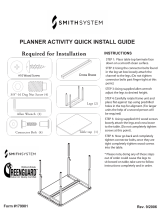 SMITH SYSTEM 179901 Assembly Instructions
SMITH SYSTEM 179901 Assembly Instructions
-
PIXEL Pixel LED Ring Light Installation guide
-
DUROGREEN AAC3529SETCH Operating instructions
-
Broan Snow Stand Kit Installation guide
-
Reznor JT4BE Installation guide
-
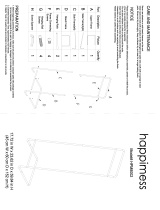 happimess HPM8002B Operating instructions
happimess HPM8002B Operating instructions



























